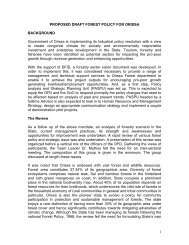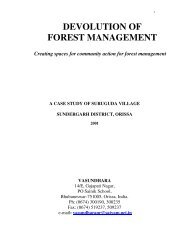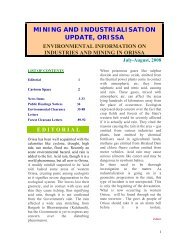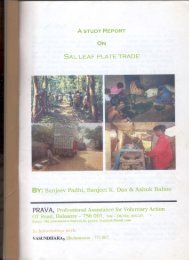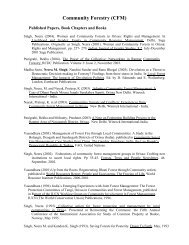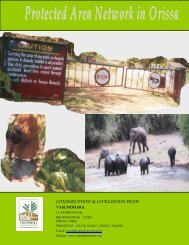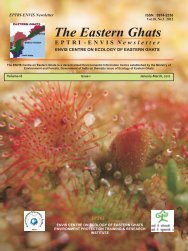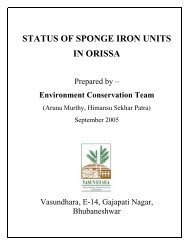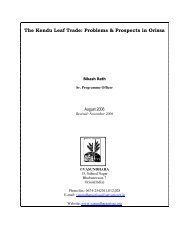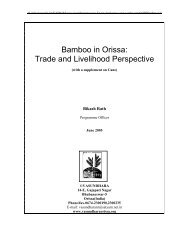Bryoflora of Baphalimali hill ranges in Eastern Ghats ... - Vasundhara
Bryoflora of Baphalimali hill ranges in Eastern Ghats ... - Vasundhara
Bryoflora of Baphalimali hill ranges in Eastern Ghats ... - Vasundhara
- No tags were found...
Create successful ePaper yourself
Turn your PDF publications into a flip-book with our unique Google optimized e-Paper software.
BIBLIOGRAPHY OF BRYOPHYTESEPTRI - ENVIS Newsletteranthropogenic and accessibility factors have beengathered correspond<strong>in</strong>g with fire presence/absence. Alogistic regression model was used to estimate theprobability <strong>of</strong> the presence <strong>of</strong> fires as a function <strong>of</strong> theexplanatory variables. Results for fire area estimates2suggested that, <strong>of</strong> the total fires cover<strong>in</strong>g 47,043kmthat occurred dur<strong>in</strong>g the year 2000 for the entireIndian region, 29.0% occurred <strong>in</strong> the Deccan Plateau,with Andhra Pradesh hav<strong>in</strong>g 13.5%, Karnataka14.7%, Kerala 0.1%, and Tamilnadu 1.15%. Resultsfrom the logistic regression suggest that the strongest<strong>in</strong>fluences on the fire occurrences were the amount <strong>of</strong>forest area, biomass densities, rural populationdensity (PD), average precipitation <strong>of</strong> the warmestquarter, elevation (ELE) and mean annualtemperature (MAT). Among these variables, biomassdensity (BD) and average precipitation <strong>of</strong> thewarmest quarter had the highest significance,followed by others. These results on the bestpredictors <strong>of</strong> forest fires can be used both as a strategicplann<strong>in</strong>g tool to address broad scale fire riskconcerns, and also as a tactical guide to help forestmanagers to design fire mitigation measures at thedistrict level.Behera, S. K. and M. K. Misra. 2006. Abovegroundtree biomass <strong>in</strong> a recover<strong>in</strong>g tropical sal (Shorearobusta Gaertn. f.) forest <strong>of</strong> <strong>Eastern</strong> <strong>Ghats</strong>, India.Biomass and Bioenergy, 30(6): 509-521Aboveground biomass <strong>of</strong> <strong>in</strong>dividual treespecies by component and total biomass per unit areafor four different stages <strong>of</strong> a recover<strong>in</strong>g tropical drydeciduous forest stands, dom<strong>in</strong>ated by sal (Shorearobusta Gaertn. f.) <strong>of</strong> the <strong>Eastern</strong> <strong>Ghats</strong>, India were<strong>in</strong>vestigated dur<strong>in</strong>g 2001–2002. Different periods <strong>of</strong>recover<strong>in</strong>g (2, 4, 6, and 10-year) forest stands (84°132E, 20°292 N) were selected <strong>in</strong> the Kandhamal district<strong>of</strong> Orissa, India and sample trees <strong>of</strong> all species wereharvested. Tree species diversity was 23, 23, 21 and22 <strong>in</strong> 2, 4, 6, and 10-year recover<strong>in</strong>g stands,respectively. Species-wise Ixora pavetta showed thehighest biomass <strong>in</strong> 2 and 4-year stands while Shorearobusta <strong>in</strong> 6 and 10-year stands. Component-wise, <strong>in</strong>all species, bole–wood contribution ranged between22.6% and 60.9%. Aboveground tree biomass, <strong>in</strong> allthe stands, was dom<strong>in</strong>ated by Shorea robusta, which”1ranged between 12.68 and 231.91 Mg ha . Totalaboveground tree biomass was 30.12, 49.21, 107.54”1and 261.08 Mg ha <strong>in</strong> 2, 4, 6 and 10-year stands,respectively.7Vol. 15, No.1, 2009BIBLIOGRAPHY OF BRYOPHYTESAhmad, S. 1942. Three new species <strong>of</strong> Riccia from India.Curr. Sci. 11: 433 – 434.Asthana, A.K. & S.C. Srivastava. 1991. Indian Hornworts(A taxonomic study). Bryophyt. Biblioth. 42: 1 –158.Asthana, G. 2001. Present status <strong>of</strong> the genus Cololejeunea<strong>in</strong> India. In: V. Nath & A.K. Asthana (ed.),Perspectives <strong>in</strong> Indian Bryology, 209 – 217.Dehra DunAsthana, G., S.C. Srivastava & A.K. Asthana 1995. Thegenus Cheilolejeunea <strong>in</strong> India. L<strong>in</strong>dbergia 20:125 – 143.Awasthi, U.S. 1986. The genus Leptolejeunea (Spruce)Steph. <strong>in</strong> India. J. Indian Bot. Soc. 65: 117 – 123.Awasthi, U.S. & R. Udar. 1984. The genus Mastigolejeunea(Spruce) Schiffn. <strong>in</strong> India. Proc. Indian Acad.Sci. (Pl. Sci.) 93: 485 – 494.Bapna, K.R. 1968. A new record <strong>of</strong> Petalophyllum <strong>in</strong>dicumKash. From Western <strong>Ghats</strong>. Curr. Sci. 37: 173 –175.Bapna, K.R. & B.L. Chaudary. 1980. Contributions onIndian Hepatics I. (1951 – 1960). Misc. Bryol.Lichénol. 8: 169 – 172.Bapna, K.R. & B.L. Chaudary. 1981a. Contributions onIndian Hepatics II. (1961 – 1970). Misc. Bryol.Lichénol. 9: 18 – 23.Bapna, K.R. & B.L. Chaudary. 1981b. Contributions onIndian Hepatics III. (1971 – 1980). Misc. Bryol.Lichénol. 9: 59 – 63.Bapna, K.R. & B.L. Chaudary. 1982. Contributions onIndian Hepatics III. (1971 – 1980). Misc. Bryol.Lichénol. 9: 93 – 94.Bruehl, P. 1931. A census <strong>of</strong> Indian mosses with analyticalkeys to the genera. Rec. Bot. Surv. India 13(1): 1– 135; 13(2): 1 – 152.Chopra, R.S. 1943. A census <strong>of</strong> Indian Hepatics. J. IndianBot. Soc. 22: 237 – 260.Chopra, R.S. 1975. Taxonomy <strong>of</strong> Indian mosses. NewDelhi.Daniels, A.E.D. 1998. Ecological adaptations <strong>of</strong> somebryophytes <strong>of</strong> the Western <strong>Ghats</strong>. J. Ecobiol. 10:261 – 270.Daniels, A.E.D. 2001. Cololejeunea furcilobulata (Berrieet Jones) Schuster and Heteroscyphus argutus(Re<strong>in</strong>w. et al.) Schiffn. from Mahendragiri <strong>hill</strong>s<strong>of</strong> Kanyakumari District <strong>of</strong> South India. In:Nath, V. & A.K. Asthana (ed.), Perspectives <strong>in</strong>Indian Bryology, 301 – 307. Dehra Dun.Daniels, A.E.D. 2004. Bryophytes. In: Annamalai, R. (ed.),Tamil Nadu Biodiversity Strategy and Actionplan.Wild Plant Diversity: 49 - 70. Government<strong>of</strong> Tamil Nadu, Chennai.



